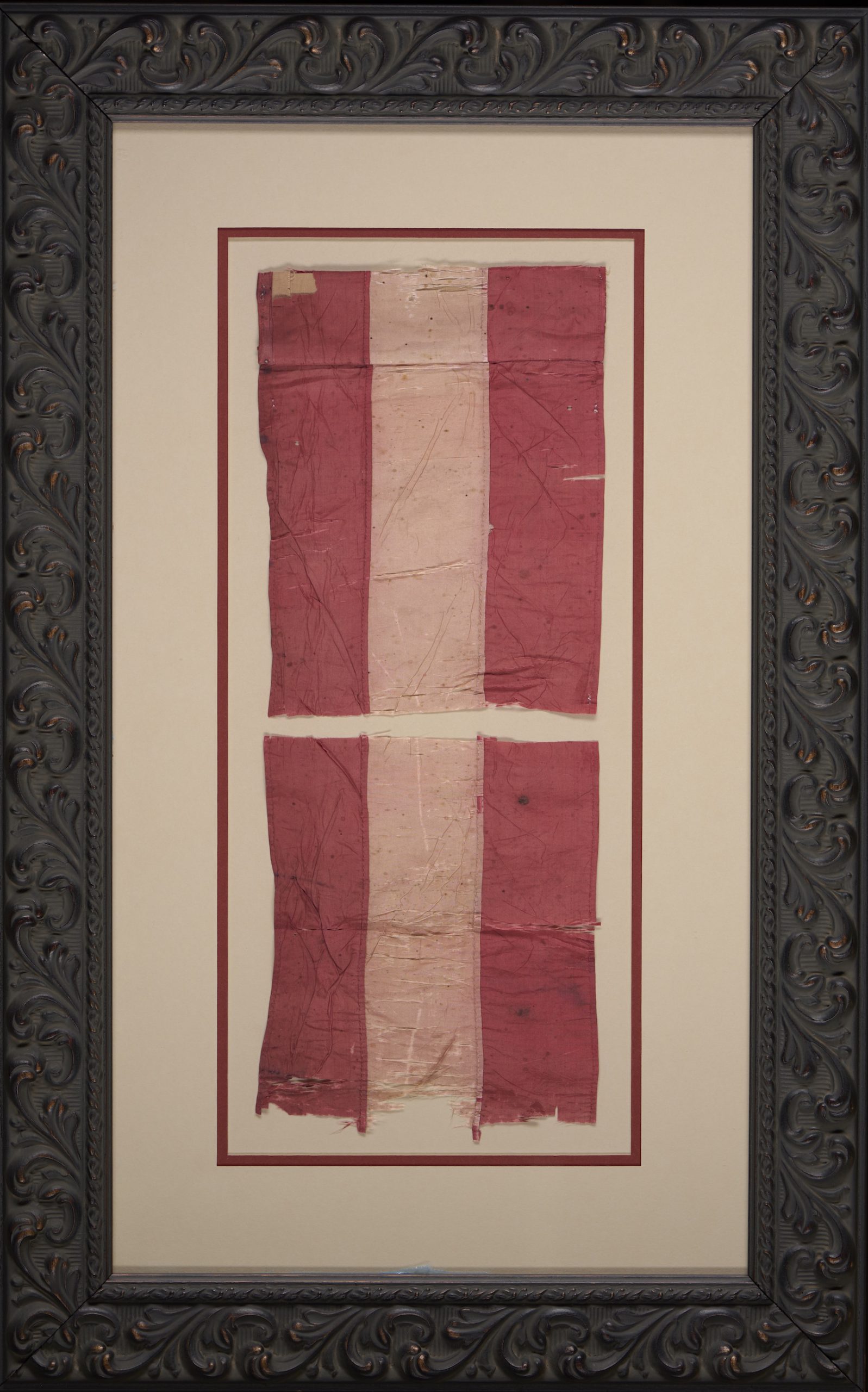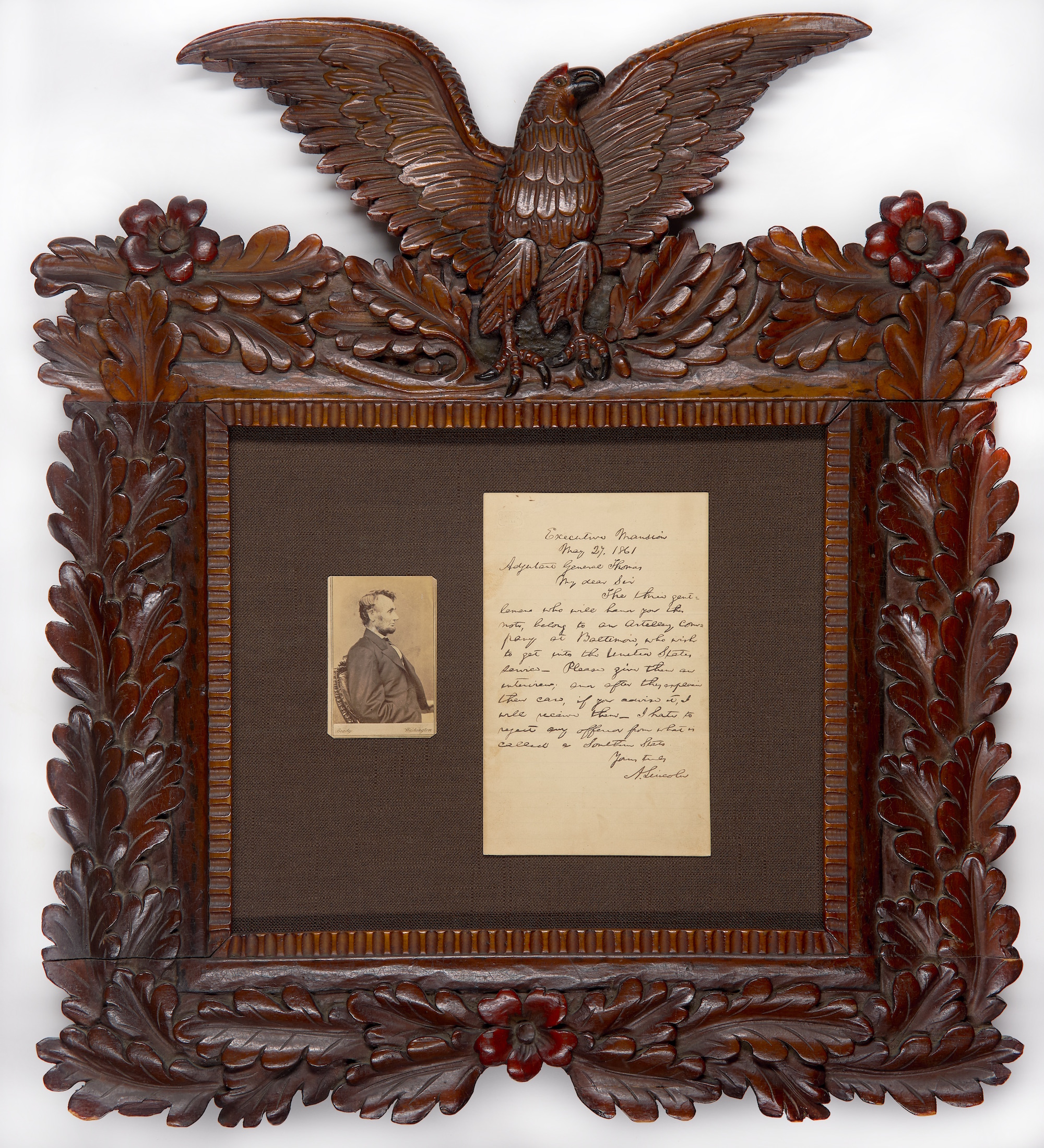a superb early-war letter by Abraham Lincoln on Southern volunteers & American flag bunting from Lincoln's box at Ford's Theatre
LINCOLN, ABRAHAM. Autograph letter signed as President to Adjutant General Lorenzo Thomas [with] American flag bunting from Lincoln’s box at Ford’s Theatre
Washington, Executive Mansion, May 27, 1861
One page. Light soiling. Traces of mounting on verso.
Provenance: John D. Crimmins, his sale, Anderson, April 8, 1907, lot 104.
Beautifully presented in a spectacular 19th-century carved wood frame with surmounted eagle.
[framed with]
(BRADY STUDIO.) Anthony Berger. Abraham Lincoln. Washington: Mathew Brady, February 9, 1864. Albumen print (3 1/4 x 2 1/4 in.), carte- de-visite mount signed “Brady / Washington.” This famous portrait, the “Penny Profile,” was the basis for the Lincoln cent minted from 1909 to the present.
The unvignetted form of this famous portrait is very rare.
Abraham Lincoln, writing at the outset of the Civil War, recommends that the Army admit three volunteers from the highly divided city of Baltimore. He advises Adjutant General Lorenzo Thomas, “I hate to reject any [volunteers] offered from what is called a Southern State.”
Maryland’s Southern sympathies were of paramount concern to Lincoln. On February 23, 1861, learning of a rumored assassination plot, president-elect Lincoln passed through Baltimore in secrecy to reach Washington. On April 19, 1861, just a week after the surrender of Fort Sumter, a mob killed four soldiers and wounded thirty-six more when the 6th Massachusetts Infantry passed through Baltimore en route to Washington. A week later Lincoln suspended the writ of habeas corpus to maintain control in the state. Maryland’s governor had ordered the militia to burn railroad bridges north of the city to prevent more federal troops from coming through the city. Finally on May 13 federal troops occupied the city, quelling pro-Confederate unrest.
In this fine letter written just days later, Lincoln asks Adjutant General Lorenzo Thomas, “The three gentlemen who will hand you this note, belong to an Artillery Company at Baltimore, who wish to get into the United States service. Please give them an interview; and after they explain their case, if you advise it, I will receive them. I hate to reject any offered from what is called a Southern State.”
The following day the New York Herald reported that Lincoln had accepted the Eagle Artillery of Baltimore. Over the next two weeks Unionists swept the city, collecting arms from fellow Unionists and discovering large caches of rebel weapons. The Eagle Artillery itself contributed four cannon and forty muskets for the war effort. Finally in July 1863 the company was mustered in.
This outstanding letter from the earliest days of the Civil War reflects Lincoln’s intense desire to keep the people of Baltimore, Maryland and the neighboring border states in the Union and to bring in new recruits, wherever he could find them.
Important Lincoln letters relating to his concern about Baltimore and Maryland in the early days of his presidency are of great rarity.
OFFERED WITH:
American flag bunting from Lincoln’s box at Ford’s Theatre
(LINCOLN ASSASSINATION.)
Silk U.S. Flag Bunting from the Presidential Box at Ford’s Theatre the Night of the Assassination. Ford’s Theatre, April 14, 1865.
Section of an American flag in two pieces (upper half 6 1⁄2 x 8 1⁄4 in., lower half 6 1⁄4 x 7 1⁄2 in.). Horizontal separations, light loss and fraying, some stains. Oriented vertically. Handsomely framed.
This is a section of the bunting from the presidential box at Ford’s Theatre where Abraham Lincoln was shot by John Wilkes Booth on April 14, 1865. Harry C. Ford, manager of stage shows at Ford’s Theatre, preserved the bunting and a few weeks later gave this section to John A. Ellinger (see Provenance).
On the morning of April 14, 1865, Harry and Dick Ford, managers of Ford’s Theatre, received word that Abraham Lincoln had requested four box seats for that evening’s performance of Our American Cousin. They immediately placed notices in the afternoon newspapers and set about selecting a box for the president. They decorated the box with flags borrowed from the Treasury department and elsewhere, with Harry Ford overseeing the work.
Lee had surrendered to Grant at Appomattox five days earlier, and the city was in a festive mood. When Lincoln and his party arrived eleven minutes into the show, the orchestra played “Hail to the Chief,” and the audience stood and cheered. Two hours later John Wilkes Booth entered Lincoln’s box and shot the president in the back of the head. Jumping to the stage twelve feet below, Booth landed awkwardly on his left leg and limped away, shouting “Sic semper!” or “Sic semper tyrannis!” (“Thus always to tyrants”).
The bunting has an impeccable provenance. It came into the possession of Oliver R. Barrett, perhaps the greatest of all Lincoln collectors, and it was sold at his Parke Bernet auction in 1952. Elsie O. and Philip D. Sang, the leading Lincoln and Civil War collectors of the second half of the century, then acquired it. The bunting was sold in 1981 at the fifth Sang sale, and has since been owned by two other leading Lincoln collectors, Dr. John K. Lattimer and Dr. Blaine Houmes.
“The term ‘draped’ [used by Ellinger, who received the bunting from Ford] would seem to indicate that this piece was from one of the two flags draped on the presidential-box balustrades and not mounted on a pole. … Known Provenance: Oliver R. Barrett Lincoln Collection … It is not known where the item is today” (“The Oliver R. Barrett artifact” in Smyth & Garrett, The Lincoln Assassination: The Flags of Ford’s Theatre, p. 70).
This is an evocative relic from a sacred place in American memory and one of the most momentous events in American history.
A remarkable provenance:
1. Harry C. Ford of Ford’s Theatre
2. John A. Ellinger
3. Y. Bush
and then a succession of some of the leading Lincoln collectors of their eras:
4. Oliver R. Barrett, his sale Parke- Bernet Galleries, February 19-20, 1952, lot 662, that description referring to a then-accompanying letter by John A. Ellinger, Department of Justice, Washington, June 9, 1911, stating in part “This is to certify that the part of the silk flag red and white stripes, 6 1⁄4 x 18 with a part of the blue band 2 x 4 1⁄2 [not present] now in possession of Mr. Y. Bush is the identical piece of the flag presented to me by Mr. H. C. Ford in May 1865, and the same has been in my possession ever since”
5. Elsie O. and Philip D. Sang, with Sang collection printed sheet, Sotheby Parke Bernet, December 4, 1981, part of lot 1239
6. Dr. John Lattimer, with his inscription on the Sang sheet “Bunting from Box 7 Ford’s Theater April 14, 1865 – the night Lincoln was shot in that box. JKL 82.87”
7. Dr. Blaine Houmes.
two items: $275,000




